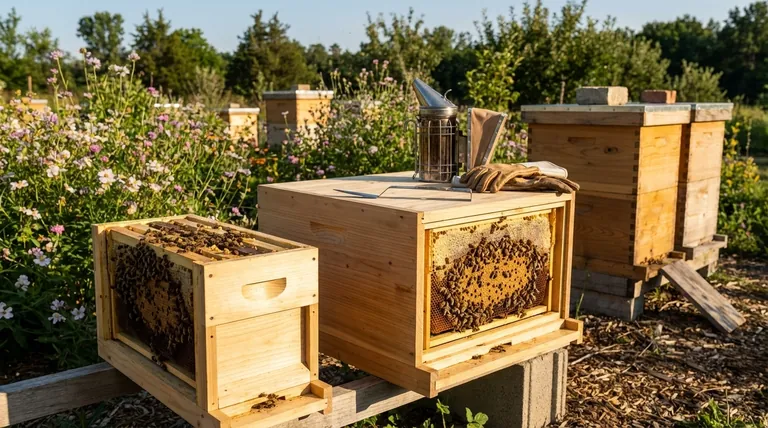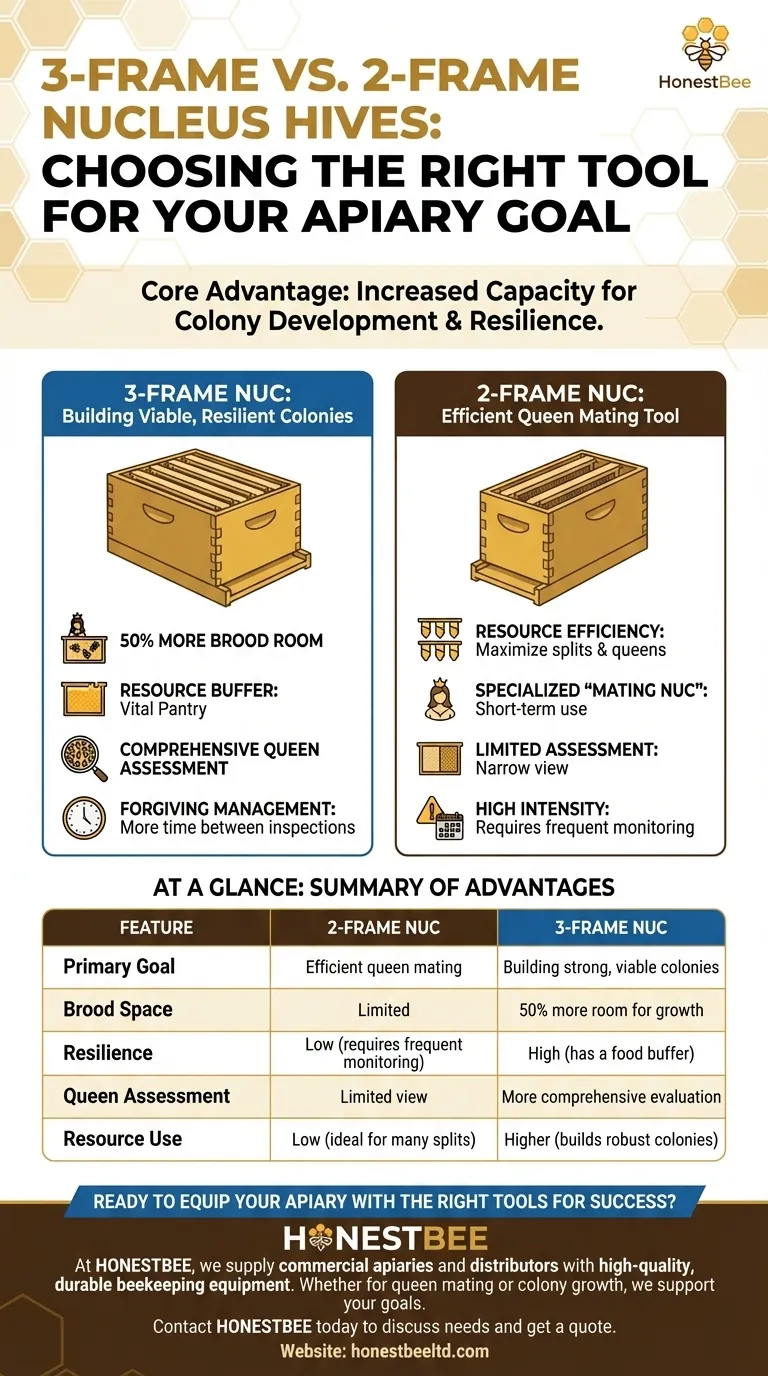At its core, the advantage of a 3-frame nucleus hive (nuc) over a 2-frame nuc is its increased capacity for colony development and resilience. This additional space allows a queen to lay eggs for a longer period, fostering a larger population and giving the beekeeper a wider margin for error before the colony must be moved into a larger hive.
The choice between a 2-frame and 3-frame nuc is not about which is "better," but which tool is right for the job. A 3-frame nuc is designed to build a viable, resilient colony, while a 2-frame nuc is a specialized tool for efficiently mating queens with minimal resource investment.

The Core Advantage: More Room for Growth
A nucleus hive's primary purpose is to nurture a small colony, typically centered around a new queen. The amount of space you provide directly impacts how successfully and quickly this can happen.
Fostering a Stronger Brood Nest
A prolific queen can fill two frames with eggs and larvae in a surprisingly short time. Once she runs out of laying space, the colony's growth stalls.
A 3-frame nuc provides 50% more room for brood. This allows the queen to establish a more robust and continuous laying pattern, which is a key indicator of her quality. This larger brood nest hatches into a larger workforce, accelerating the colony's journey to self-sufficiency.
Creating a Resource Buffer
A beehive is a delicate ecosystem. A 2-frame nuc is extremely vulnerable, with nearly all its space dedicated to brood. It has almost no room to store the honey and pollen needed to survive a few days of bad weather.
The third frame in a nuc often serves as this vital pantry. By holding reserves of food, it makes the colony more resilient and less dependent on constant feeding or ideal foraging conditions.
Gaining a Clearer Picture of Queen Quality
Assessing a new queen is a critical task. You are looking for a solid, compact brood pattern without significant gaps.
With only two frames, your assessment is limited. A 3-frame nuc gives you a more comprehensive view of the queen's performance over time, ensuring you are raising a high-quality, productive queen before committing her to a full-sized production hive.
Understanding the Trade-offs: When a 2-Frame Nuc Makes Sense
While a 3-frame nuc builds a more robust colony, the 2-frame version exists for a specific and important reason: resource efficiency.
The Principle of Resource Conservation
Bees are a valuable resource. Starting a nuc requires pulling frames of brood, bees, and food from a strong, established hive. A 3-frame nuc requires significantly more of these resources than a 2-frame nuc.
If your goal is to make many splits or mate many queens, this resource cost adds up quickly. You can create three 2-frame nucs using the same number of bees and brood required to create two 3-frame nucs.
The Specific Use Case: Queen Mating
The 2-frame nuc excels as a "mating nuc." Its sole purpose is to provide just enough population and space to support a virgin queen through her mating flights and the start of her laying career.
Beekeepers using them this way are not trying to build a colony in them. Once the queen is successfully mated and laying well, she is typically moved to a larger nuc or hive, and the 2-frame box is reset for the next virgin queen.
Management Intensity
A 2-frame nuc is a high-intensity management tool. It is fragile and can become honey-bound or brood-bound defectos in a matter of days. It requires frequent monitoring.
A 3-frame nuc is more forgiving. The extra space acts as a buffer, giving the beekeeper more time and flexibility between inspections.
Making the Right Choice for Your Goal
Select your equipment based on your specific objective.
- If your primary focus is creating strong, viable starter colonies for sale or apiary growth: The 3-frame nuc is the superior choice, as it builds a more resilient and populous colony faster.
- If your primary focus is maximizing the number of mated queens with minimal resources: The 2-frame nuc is the more efficient tool for this specialized, short-term task.
- If your primary focus is overwintering a small colony: Neither is ideal, but a 3-frame nuc is the minimum starting point. A 5-frame nuc is the standard recommendation for overwintering.
Ultimately, understanding your own goals is the key to choosing the right equipment for your apiary.
Summary Table:
| Feature | 2-Frame Nuc | 3-Frame Nuc |
|---|---|---|
| Primary Goal | Efficient queen mating | Building strong, viable colonies |
| Brood Space | Limited | 50% more room for growth |
| Resilience | Low (requires frequent monitoring) | High (has a food buffer) |
| Queen Assessment | Limited view | More comprehensive evaluation |
| Resource Use | Low (ideal for many splits) | Higher (builds robust colonies) |
Ready to equip your apiary with the right tools for success?
At HONESTBEE, we supply commercial apiaries and beekeeping equipment distributors with the high-quality, durable nucleus boxes and beekeeping supplies needed to build resilient, productive colonies. Whether your focus is efficient queen mating or creating strong starter colonies, our wholesale-focused operations provide the reliable equipment to support your goals.
Contact HONESTBEE today to discuss your specific needs and get a quote on our beekeeping supplies.
Visual Guide

Related Products
- HONESTBEE Professional Long Handled Hive Tool with Precision Cutting Blade
- Professional Multi-Function Stainless Steel Hive Tool
- 3.5L Plastic Beehive Frame Feeder Deep Frame Water Feeder for In Hive Use
- Professional Hive Front Entrance Bee Feeder
- Boardman Entrance Bee Feeder Durable Galvanized Steel and Wood Construction for Beekeeping
People Also Ask
- What is a hive tool used for in beekeeping? Your Essential Guide to Hive Management
- How can a hive tool be used to remove propolis and burr comb? Master Hive Maintenance for a Healthy Colony
- What are some common uses of a hive tool? Essential Multi-Purpose Tool for Every Beekeeper
- How should beekeepers handle bees when using a hive tool? Master Calm, Deliberate Techniques
- What tools are used for cleaning frames? A Beekeeper's Simple 4-Tool Guide



















